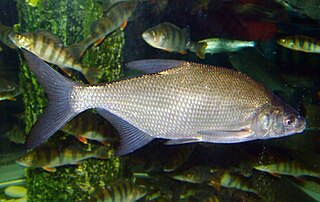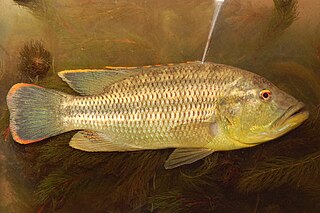
Sparidae is a family of ray-finned fishes belonging to the order Spariformes, the seabreams and porgies, although they were traditionally classified in the order Perciformes. They are found in shallow temperate and tropical waters around the world and are demersal carnivores.

Lepomis or true sunfish is a genus of North American freshwater fish from the family Centrarchidae in the order Centrarchiformes. The generic name Lepomis derives from the Greek λεπίς ("scale") and πῶμα. The genus' most recognizable species is perhaps the bluegill.

The common bream, also known as the freshwater bream, bream, bronze bream, carp bream or sweaty bream, is a European species of freshwater fish in the family Cyprinidae. It is now considered to be the only species in the genus Abramis.
Black bream may refer to one of several fish species:

Chilotilapia is a genus of freshwater fish in the cichlid family. It contains the sole species Chilotilapia rhoadesii, the Malawi bream, which is endemic to Lake Malawi in East Africa, where it prefers areas with muddy substrates from the shallows to quite deep waters. Its primary food consists of Melanoides and Lanistes snails. It can reach a length of 22.5 centimetres (8.9 in) TL. Though commonly called a "bream", this is due to its looks as it is quite unrelated to the breams proper, which are cypriniform fishes. This species is also found in the aquarium trade.

Acanthobrama is a genus of ray-finned fish in the family Cyprinidae found mostly in the Near East.

Serranochromis is a genus of relatively large, robust cichlids from freshwater habitats in mainland Southern Africa, ranging as far north as DR Congo and Tanzania, with the highest species richness in the upper Zambezi, Okavango and Congo basins. They are typically known as largemouths or, especially among fishers, breams. Serranochromis are mostly piscivores and they are important in local fisheries.

The black bream, also commonly known as the southern black bream, southern bream and blue-nosed bream, is a species of anadromous ray-finned fish of the porgy family Sparidae. A deep-bodied fish, it is occasionally confused with other similar species that occur within its range, but is generally distinguished from these species by a lack of yellow ventral and anal fins. Southern black bream are endemic to the southern coasts of Australia from Shark Bay in Western Australia to Ulladulla, New South Wales, as well as Tasmania.

Acanthopagrus australis, the yellowfin bream, also known as sea bream, surf bream, silver bream or eastern black bream, is a species of marine and freshwater fish of the porgy family, Sparidae. It is a deep-bodied fish, occasionally confused with Acanthopagrus butcheri, but is generally distinguished by its yellowish ventral and anal fins. It is a popular target for recreational fishermen due to its capacity to fight well above its weight coupled with its table quality.
The white Amur bream is a species of cyprinid freshwater fish, of the monotypic genus Parabramis. It is native to eastern Asia, where found from the Amur River basin in Russia south to Ningbo and Shanghai in China. It is an important food fish, and has been introduced to regions outside its native range.

Eels are ray-finned fish belonging to the order Anguilliformes, which consists of eight suborders, 20 families, 164 genera, and about 1000 species. Eels undergo considerable development from the early larval stage to the eventual adult stage and are usually predators.
A bream is a common name for numerous species of fish, particularly Abramis brama.
Dendronucleata is a genus of small parasitic spiny-headed worms. It is the only genus in the family Dendronucleatidae. This genus contains three species that are distributed globally, being collected in North America and Asia. The distinguishing features of this genus among Archiacanthocephalans is the presence of randomly distributed dendritically branched giant hypodermic nuclei. Dendronucleata parasitize freshwater fish and a salamander by attaching themselves in the intestines using their hook covered proboscis and adhesives secreted from cement glands.

The Wuchang bream is a species of freshwater ray-finned fish belonging to the family Xenocyprididae, the East Asian minnows or sharpbellies. This species is found in bodies of water throughout the Yangtze basin, China, including Liangzi Lake. It is an important object of fish farming, and in 2012 its total production ranked 12th on the world list of most important fish species in aquaculture, with a total weight of 0.71 million tons and value of 1.16 billion US dollars.

Megalobrama mantschuricus, the black bream, is a species of freshwater ray-finned fish belonging to the family Xenocyprididae, the East Asian minnows or sharpbellies. This fish is found from the Amur river in eastern Russia south throug the major rivers of China to northern Viet Nam.
Megalobrama pellegrini is a species of freshwater ray-finned fish belonging to the family Xenocyprididae, the East Asian minnows or sharpbellies. This fish is endemic to upper reaches of the Yangtze River. It grows to 25 cm (9.8 in) TL.
Megalobrama skolkovii is a species of freshwater ray-finned fish belonging to the family Xenocyprididae, the East Asian minnows or sharpbellies. It is the type species of the genus Megalobrama. This species is found in the upper reaches of Yangtze.

The black Amur bream is a species of freshwater cyprinid fish in the genus Megalobrama.

The stone bream is a species of marine ray-finned fish, a sea chub from the family Kyphosidae, which is native to the Indian Ocean coast of Africa where it can be found along rocky coasts from Mozambique to South Africa. This species grows to a length of 50 centimetres (20 in) SL though most do not exceed 18 centimetres (7.1 in). The greatest recorded weight for this fish is 2.6 kilograms (5.7 lb). This species is commercially important and is also popular as a game fish. This species is the only known member of its genus.

Acanthopagrus berda, the goldsilk seabream, sly bream, picnic seabream, black sea bream, black porgy, picky bream, silver bream or river bream, is a species of ray-finned fish belonging to the family Sparidae, the sea breams and porgies. This species is found in the Indian Ocean.














